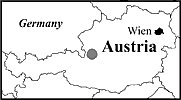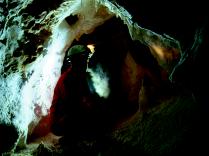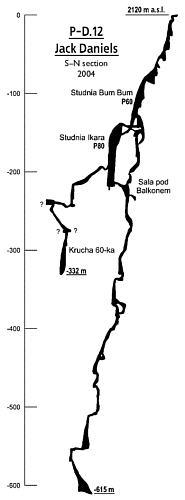 Achievements in Tennengebirge Ost
Achievements in Tennengebirge Ost
|
Rajmund Kondratowicz |
Speleoklub "Bobry" Żagań |
 |
|
Kammerschartenhöhle ph. M.
Bochynek
|
The east part of the Tenncngcbirge massif in Austria is the area of cave exploration for Żagań cavers since 1979. We discovered over 150 caves during 21 expeditions to this unusual karst area. Most of them are vertical caves with very small horizontal extent, located on the karst plateau under the peaks of Bleikogel, Langwand and Breitstein. Exception to this are caves located north and east from the Griesskogel which are longer and more complicated morpho logicalIy. Their passages have lots of horizontal trunks and galleries.
Exploration of the area started 26 years ago, and was very systcmatic, due to expeditions that ran each year. The current outcome took a lot of work and time. The first expedition in 1979 was a reconnaissance that despite previous speculations proved that the area has a huge caving potential. Many caves were discovered but the first spectacular success came in 1981.
In pit named Hades and marked P-14, we reached the depth of 455 m, so for 13 years it was the deepest pit in the world. At the same time exploration was conducted in caves P-19 Czerwony Pająk and P-4 Meandrująca. The effect of this was reaching depth of 1029 m in Meandrująca cave and 138 m in Czcrwony Pająk cave with interesting horizontal passages at various levels, rare in this part of the Tennengcbirge.
The next expeditions again were reconnaissance trips again. However, in 1988 a new cave named Kaskadowa P-28 was discovered and explored till the depth of 559 m. The cave has still good exploration possibilities but a continuous water flow in a narrow horizontal passage makes it very hard. Exploration of Hedwigshohle P-35, discovered in 1988 and known also as Bleikogelhohle was also interesting as the cave reached the -1014 m mark in 1996. Second bottom -1023 m was discovered a year later. It is the second cave in the eastern part of Tennengebirge deeper than 1000 meters and explored entirely by Polish cavers, namely from Zagah, Bielsko Biała, Gorzów, Wałbrzych and Warszawa.
In the late nineties our expeditions were focused on surface exploration. We again started looking for now caves, and returned toCzerwony Pająk. After a couple of years of little or no successes, 1999 was a year of big discoveries in this cave. Depth of -440 m and length of ok. 3,2 km was achieved and there is still more potential there. Two big caves in the area were also discovered Pod Modrzewiem P-77, and Pod Śnieżnymi Korkami P-84. The deeper P-77 did not end but the exploration was stopped due to water in tight passages, as in P-19 and P-28.
In P-84 exploration was finished with total length of 3,6 km and depth -280 m. It is possible that there is a way to connect it with P-19 and P77 as they arc close to each other and have similar morphology.
The last two expeditions dealt mainly with a cave discovered in 2003 - P-D.12 Jack Daniels. In August 2004 we reached the depth of 615 m in its eastern branch . The exploration of the western branch has been not finished but will continue because the passage develops in a promising way. The cave is now 2 km long and the exploration will be continued in 2005.![]()
See also:
Kondratowicz R., 1997. Drugi polski Tysiąc w Tennengebirge. Jaskinie, 6:1-3.
Kondratowicz R., 1998. Tennengebirge Ost - deszcz, śnieg, budowa. Jaskinie, 8:15.
Furtak M., 1998. W sieci Czerwonego Pająka: ,"Bobry" w Tennengebirge Ost. Jaskinie, 13:12-13.
Furtak M., 1999. XX lat we Wschodnim Tennengebirge. Jaskinie, 17:15-16.
Furtak M., 2000. 3600 m w Tennengebirge-Ost. Jaskinie, 21:9-11I.
Furtak M., 2001. The Tennengebirge - 1997-2000. In: Polish Caving 1997-2001. KTJ PZA, Kraków, pp. 15-17.
Furtak M., 2002. Austria 2002 Tennengebirge nie zawsze łaskawe. Jaskinie, 29:13.
Furtak M., 2004. Szósta strona świata - Tennengebirge Ost. Jaskinie, 34:23-25.
Furtak M., 2005. Nasze Tennen. Jaskinie, 39:17-20.

